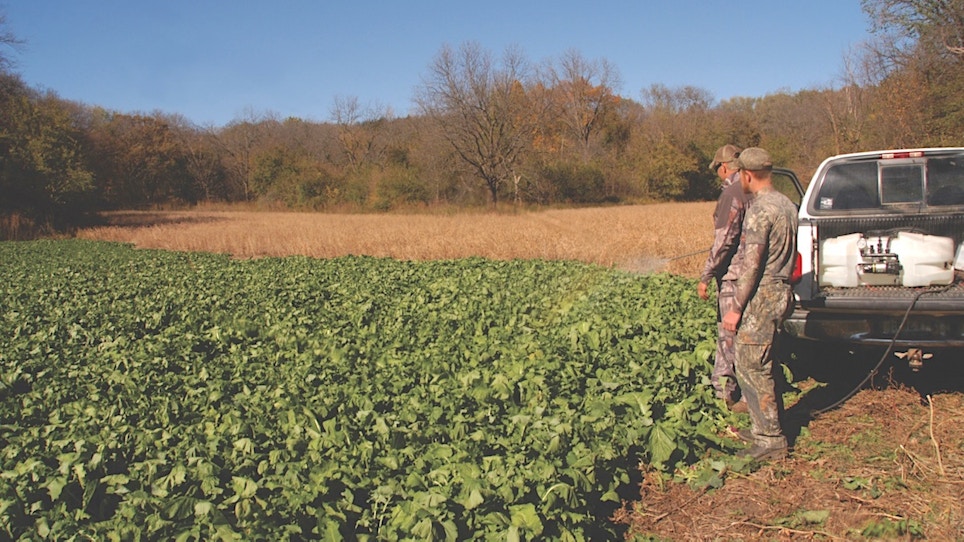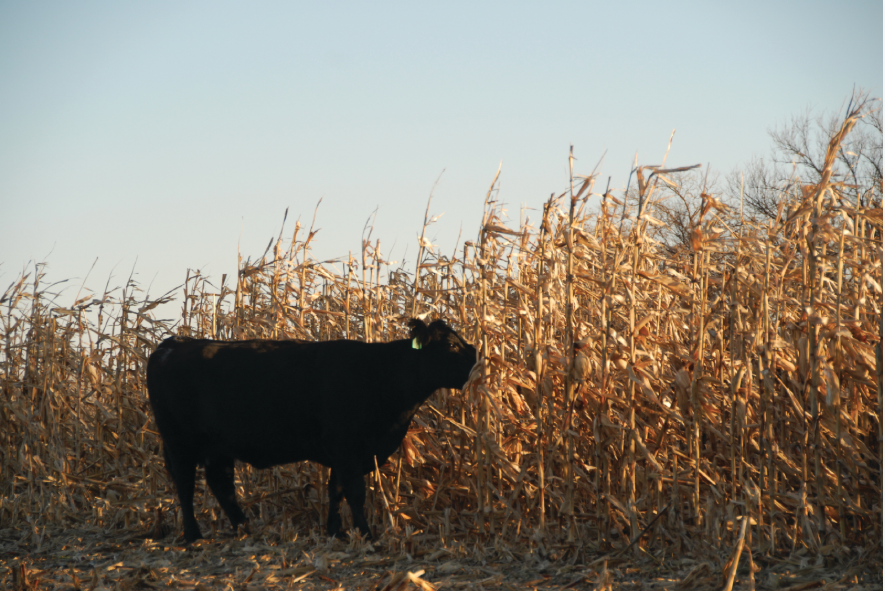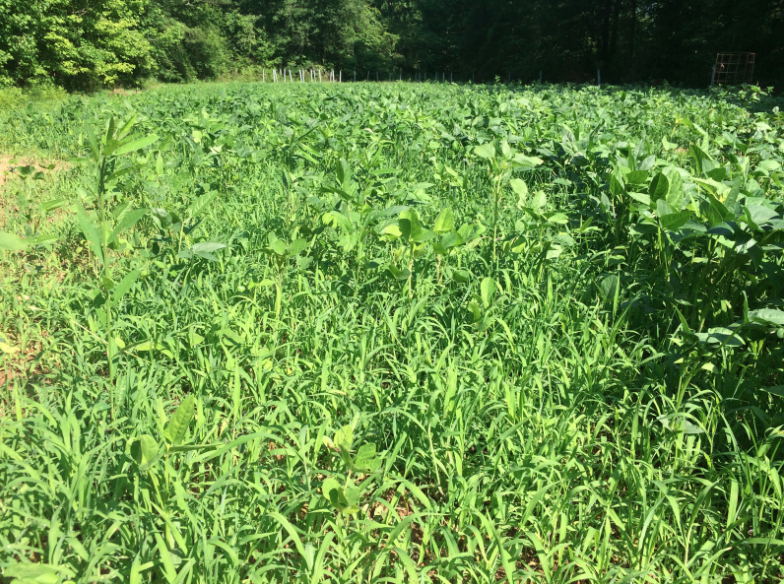I could tell from the farmer’s tone of voice that all was not well with my Iowa food plots and his question of whether I wanted the good news first or the bad did nothing to quell my apprehensions. I figured knowing the good news might override the bad so opted for it first. Wrong! The good news was the weeds inundating the upper food plot above the old house were 6 to 8 feet tall. The bad news was the damnable weeds in the 1 acre plot below the house were 10 to 12 feet tall!
So much for a sure-fire way to control Iowa’s weeds in my food plots until I could get them planted with brassicas in the fall. When I first started outfitting in Iowa, I wanted to hedge my bets and increase my client’s chances of success during the fall and early winter whitetail hunting with food plots. I was warned that Iowa’s soil is 85-percent weed seed and food plots may not be the slam dunk I was planning on. If anything, that percentage is on the low side of the scale.
When a food plot seed supplier offered to provide rye grass seed that, when planted in the early spring, would come up thick and heavy and inhibit weed growth I quickly took him up on his offer. This would definitely make it easier to disk down the grass in the early fall and plant with my favorite brassica mix — Big-N-Beasty (B-N-B) Brassicas from Frigid Forage of Onamia, Minnesota. This mixture contains high-protein annuals, forage rapes, sugar beets, forage turnips and radishes, that when planted in late summer or early fall provide exceptional deer drawing power for bowhunters and late-season firearms hunters alike. I had been using this as my main fall food plot crop along with Autumn Quick Plot which is a mix of annuals and biennials that is almost equal to the B-N-B Brassicas with winter peas, winter wheat, rye, forage radishes, rape, turnips and common vetch.
Unfortunately, the dry spring and summer didn’t get the rye germinated and the weeds took over, which meant extra days and labor mowing the weeds, disking the plots and replanting. You’d think I would have learned a lesson, but I’m always trying to find the best and most effective way to grow good food plot so this last spring when a local seed supplier, that I let predator hunt on our leases after season, offered a half dozen bags of free Roundup ready soybeans, I readily took him up on his offer. Our head guide and Wisconsin farmer, Jody Harrison hauled his Kubota tractor from Wisconsin to Iowa and when we got through planting the soybeans our food plots were as smooth and clean as any home garden plot.
With Jody’s efficient equipment we added several new plots bordering the two-track roadway near trophy producing stands on several major ridgetop crossings. In the past, the deer would cross through these openings from one timbered slope to the adjacent one. The narrow confines didn’t give the client much time to judge the trophy qualities of a moving buck, which had resulted in lost shot opportunities, a miss or two and misjudged, ground-shrinkage bucks in the past. I figured a good lush food plot along the ridgetop would stop the deer for a nibble or two giving the shooter a bit more time. With an abundant supply of free soybean seed, we didn’t shirk on the amount of seed used. I figured, if the soybeans did well, I could leave some untouched and plant a section of the plot to brassicas or Autumn Quick Plot to give me double the attracting power. Great plan!
I talked with the landowner in early summer and he said the food plots looked good, but the deer were really hammering them. He wasn’t kidding cause when I got back the first part of August all the food plots looked as if we had planted and fertilized a prime WEED crop. The weeds and grass around the plots were a foot high and those in the food plots were 6 to 8 feet tall. The soybeans were almost non-existent due to the high number of deer nipping off the tops at the most critical stage. Hind sight is always 20-20 and I realized that all the farmers on our leases had planted corn, which was planted and came up much later. This focused the deer’s full attention on my tender, young and green soybeans. Had there been adjacent fields of soybeans around my food plots to spread the use, things might have worked the way I planned. When the beans in the food plots died out early in the growing season the weeds made good use of the fertilizer we’d put on. As if they needed it! Once again, I spent a lot of extra time and money, mowing, spraying and working up the food plots to get something out of them for fall. So much for the FREE soybean seed. From now on I will spray the plots in the spring when the weeds first pop up and then spray them again when they need it during the early summer and again just before disking and planting the plots in August.
Weeds can definitely be a major food plot problem but no weeds or anything else can also create serious food plot setbacks. There is little doubt that the two major food sources for deer throughout agricultural areas are corn and soybeans. Each spring we have our landowners do what they are best equipped to do. Plant their fields like always. We then mark out a corn or soybean food plot in August for them to leave in the field come harvest time. Might be an acre or more, or as little as a quarter acre depending on location. We pay them the going rate for the crop produced. Some areas we utilize every year for food plots and in some instances, we will go into the field during our August food plot planting and disk down some standing corn or soybeans and over-seed it with brassicas. A very effective and productive way of having a highly-palatable species available to draw deer from early bow season through the late season. Something that clovers, alfalfas and other food plot species can’t do on their own.
Several years ago, crops and especially soybeans did not do well so on the advice of another seed supplier I simply went over a portion of one of our sparse low-yielding soybean food plots and broadcast fertilizer and Big-N-Beasty brassicas. I timed the planting just before a forecasted rain so the minuscule seeds would get washed into the soil. I came back in October expecting soybeans interspersed with lush brassicas. Nothing. Seems the farmer had added a pre-emergent herbicide to his Roundup spray, which prevented the brassicas from growing. I learned my lesson on that fiasco and now make sure I check with the landowner as to what they sprayed their crops with BEFORE I plant. Even that didn’t stop the same thing from happening a couple years later in our most productive food plot where, I had been following this procedure for 20 years with deadly results. My partner and I drove down a sizeable plot of 150-bushel per acre corn, fertilized and planted brassicas. Come October we expected to see the shooting lanes filled with lush ankle-deep brassicas and instead found nice black DIRT! Seems the contractor who sprayed the farmer’s fields with Roundup had left a partial tank of pre-emergent herbicide, figuring it wouldn’t cause any harm. Yeah Right! Now we check with the farmer and have him double check with the spray contractor as well as insisting on no surprises in the spray tank long before we expend the money and effort of planting.
Sometimes food plot’s attractiveness can cause problems itself. The brassicas give off a strong scent that can be a real draw to neighboring livestock and if the fences surrounding your property are not in good shape you can have some real problems.
On one of our leases, when I returned in October I found that the neighbor’s cattle had been hammering our brassica food plots. Fortunately, I had several large food plots on the lease and they hadn’t been on them long enough to completely demolish them. The neighboring farmer didn’t think much of the damage and more or less laughed it off at the time. The following year I planted a large 3½-acre plot adjacent to the timber, in a large CRP field, with corn in the spring, with the idea of disking up some of it and planting brassicas the first part of August. When I returned in August I found a dozen head of his cattle had demolished my corn crop and had to replant the whole thing to brassicas. He again laughed it off and said that come harvest time he’d dump a truck full of corn on the ravished field. Hardly, as that would constitute baiting by Iowa law and I’d be the one with the problem.
With his cavalier attitude, I figured I had better put a stop to this crap, once and for all. I filed a civil damage complaint in court for $1,500, about what it cost me in time, seed and equipment to replant. With the photographic evidence and expense records I presented, and the fact that this had happened before also substantiated with photos, it took the judge about two minutes to find him guilty and order him to pay me. We haven’t had a problem with any neighboring livestock since that day. Word travels fast in farm country.
Years ago, I had hunted upper Michigan when unlimited baiting was legal. I bowhunted over a huge pile of frozen sugar beets and was astounded by how much the deer relished them. A couple years later I got a coffee can full of experimental Roundup Ready sugar beet seed from one of our landowners. My food plot assistant, who also worked for the landowner, and I planted the tiny seeds, in one of our small food plots in the spring, by hand, with loving care. Peter, my helper sprayed the plot with Roundup several times during summer and early fall and that hunting season the deer went nuts over the huge, sweet beets. I was ready to get into the big-time sugar beet food plot planting mode, but unfortunately the EPA outlawed Roundup Ready sugar beets for general use the next year. Seed was unavailable unless you were a registered, big-time sugar beet farmer. For several years I tried to grow regular sugar beets, but quickly found they were too finicky and labor intensive for food plots. Roundup Ready sugar beets are back on the food plot market today, but after trying them a couple seasons without much success, I’ll just stick to the sure things like a good fall planted brassica mix and reap the dividends of my efforts at least until another food plot disaster comes along.
Article photos: Judd Cooney








